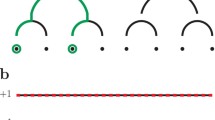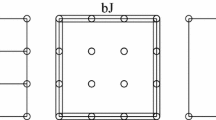Abstract
An improved version of a cluster-effective-field theory for spin glasses, namely the double-cluster approximation, is formulated. The present version is based not on theself-consistency condition, but on thedouble-cluster-consistency condition. The advantages of the approximation combined with the coherentanomaly method are discussed. The critical data of the spin-glass susceptibility are estimated for the two-, three-, and four-dimensional ±J models.
Similar content being viewed by others
References
C. Domb, On the theory of cooperative phenomena in crystals,Adv. Phys. 9:149–361 (1960).
M. Suzuki, Statistical mechanical theory of cooperative phenomena. II. Super-effectivefield theory with applications to exotic phase transitions,J. Phys. Soc. Jpn. 57:2310–2330 (1988).
M. Suzuki, Statistical mechanical theory of cooperative phenomena. I. General theory of fluctuations, coherent anomalies and scaling exponents with simple application to critical phenomena,J. Phys. Soc. Jpn. 55:4205–4230 (1986).
M. Suzuki, M. Katori, and X. Hu, Coherent anomaly method in critical phenomena. I,J. Phys. Soc. Jpn. 56:3092–3112 (1987).
P. Weiss, L'hypothèse du champ moléculaire et la propriété ferromagnétique,J. Phys. Radium 6:661–690 (1907).
M. Katori and M. Suzuki, Coherent anomaly method in critical phenomena. II. Applications to the two- and three-dimensional Ising models,J. Phys. Soc. Jpn. 56:3113–3125 (1987).
A. Patrykiejew and P. Borowski, Application of the Monte Carlo coherent-anomaly method to two-dimensional lattice-gas systems with further-neighbor interactions,Phys. Rev. B 42:4670–4676 (1990).
N. Ito and M. Suzuki, Size dependence of coherent anomalies in self-consistent cluster approximations,Phys. Rev. B 43:3483–3492 (1991).
N. Hatano and M. Suzuki, Effective-field theory of spin glasses and the coherent-anomaly method. I,J. Stat. Phys. 63:25–46 (1991).
T. Oguchi and H. Kitatani, Coherent-anomaly method applied to the quantum Heisenberg model,J. Phys. Soc. Jpn. 57:3973–3978 (1988): A. Lipowski, Coherent anomaly method with modified Bethe approximation,J. Magn. Magn. Mat. 96:267–274 (1991); Coherent anomaly method with a new mean-field type approximation,Physica A 173:293–301 (1991); Y. Nonomura and M. Suzuki, Coherent-anomaly method in zerotemperature phase transition of quantum spin systems,J. Phys. A: Math. Gen. 24 (1991).
T. Oguchi and I. Ono, Theory of critical magnetic scattering of neutrons by ferromagnet and antiferromagnet,J. Phys. Soc. Jpn. 21:2178–2193 (1966).
D. M. Burley, Closed form approximations for lattice systems, inPhase Transition and Critical Phenomena, Vol. 2, C. Comb and M. S. Green, eds. (Academic Press, London, 1972), pp. 329–374.
S. Fujiki, M. Katori, and M. Suzuki, Study of coherent anomalies and critical exponents based on high-level cluster-variation approximations,J. Phys. Soc. Jpn. 59:2681–2687 (1990); K. Tanaka, T. Horiguchi, and T. Morita, Coherent-anomaly analysis with cluster variation method for spin-pair correlation function of Ising model on square lattice,J. Phys. Soc. Jpn. 60:2576–2587 (1991).
M. Suzuki, New trends in physics of phase transitions, inEvolutionary Trends in the Physical Sciences—Proceedings of the Yoshio Nishina Centennial Symposium, M. Suzuki and R. Kubo, eds. (Springer-Verlag, 1991); M. Suzuki, N. Hatano, and Y. Nonomura, Canonicality of the double-cluster approximation in the CAM theory,J. Phys. Soc. Jpn. 60:3990–3992 (1991).
F. Matsubara and M. Sakata, Theory of random magnetic mixture. III—Glass-like phase,Prog. Theor. Phys. 55:672–682 (1976); S. Katsura and S. Fujiki, Distribution of spins and the thermodynamic properties in the glass-like (spin glass) phase of random Ising bond models,J. Phys. C: Solid State Phys. 12:1087–1099 (1979).
M. E. Fisher and M. N. Barber, Scaling theory for finite-size effects in the critical region,Phys. Rev. Lett. 28:1516–1519 (1972).
A. T. Ogielski, Dynamics of three-dimensional Ising spin glasses in thermal equilibrium,Phys. Rev. B 32:7384–7398 (1985).
R. N. Bhatt and A. P. Young, Numerical studies of Ising spin glasses in two, three, and four dimensions,Phys. Rev. B 37:5606–5614 (1988).
W. L. McMillan, Monte Carlo simulation of the two-dimensional random (±J) Ising model,Phys. Rev. B 28:5216–5220 (1983).
R. R. P. Singh and S. Chakravarty, High-temperature series expansion for spin glasses. II. Analysis of the series,Phys. Rev. B 36:559–566 (1987).
J.-S. Wang and R. Swendsen, Low-temperature properties of the±J Ising spin glass in two dimensions,Phys. Rev. B 38:4840–4844 (1988).
A. T. Ogielski and I. Morgenstern, Critical behavior of three-dimensional Ising spin-glass model,Phys. Rev. Lett. 54:928–931 (1985).
J.-S. Wang and R. H. Swendsen, Monte Carlo renormalization-group study of Ising spin glasses,Phys. Rev. B 37:7745–7750 (1988).
G. Toulouse, Theory of the frustration effect in spin glasses: I,Comm. Phys. 2:115–119 (1977).
F. J. Wegner, Corrections to scaling laws,Phys. Rev. B 5:4529–4536 (1972).
K. G. Wilson, Renormalization group and critical phenomena. II. Phase-space cell analysis of critical behavior,Phys. Rev. B 4:3184–3205 (1971).
Author information
Authors and Affiliations
Rights and permissions
About this article
Cite this article
Hatano, N., Suzuki, M. Effective-field theory of spin glasses and the coherent-anomaly method. II. Double-Cluster approximation. J Stat Phys 66, 897–911 (1992). https://doi.org/10.1007/BF01055708
Received:
Revised:
Issue Date:
DOI: https://doi.org/10.1007/BF01055708




